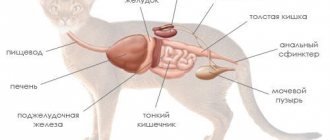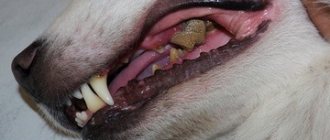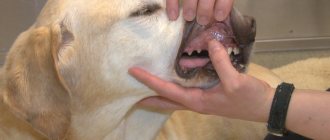When a beloved dog gets sick, the owner does everything to quickly return his pet to health. Unfortunately, our four-legged friends are susceptible to a large number of diseases that take a long time and are difficult to treat. These problems include liver disease in dogs.
The liver is one of the most important organs in the animal’s body, which has a unique ability to recover even if the disease has affected more than 50% of its volume. The quality and length of your pet’s life depends on the condition of the liver.
Signs that indicate liver disease in dogs
Liver problems in dogs are insidious in that their symptoms appear in the later stages, when treatment no longer helps enough or does not help at all, so you need to monitor your pets very carefully.
Common symptoms that may indicate liver disease:
- poor appetite;
- refusal to eat;
- losing weight for a dog;
- lethargy.
In addition, specific symptoms arise:
- Jaundice, expressed by yellowing of the whites of the eyes.
- Change in the color of stool - it becomes very pale, almost colorless.
- Increased drowsiness, apathy.
- Hepatic encephalopathy, which is accompanied by a change in the dog’s behavior and can manifest itself as excessive affection and aggression, as well as inappropriate behavior.
- Problems with the gastrointestinal tract - vomiting, diarrhea, flatulence are the causes of the disease - cholecystitis in dogs: symptoms and treatment are described here.
- Bruises and pinpoint hemorrhages on the skin may occur due to decreased blood clotting.
- Dry skin, irritation, itching.
- Thirst.
- Abdominal ascites in a dog, accompanied by an increase in abdominal volume due to fluid accumulation.
Do not ignore any signs of illness in your dog and contact your veterinarian at the slightest suspicion. Maybe this will save your dog's life.
Symptoms, manifestations
Clinical signs of liver cancer in dogs are very nonspecific and largely depend on the localization of the oncological process, the degree, depth of the lesion, and the histology of the liver tumor.
In most cases, oncology of the hepatobiliary system is asymptomatic in the initial stages of development. Signs of the disease are mild. Dogs are brought to the veterinary clinic only when the oncological disease has become severe.
Characteristic symptoms of liver cancer in animals:
- yellowness of the eyes and mucous membranes due to bile entering the blood;
- reduction, refusal of food;
- general weakness, depression, drowsiness, lethargy;
- decreased activity;
- increased thirst;
- frequent urination;
- cachexia, dyspeptic disorders;
- intra-abdominal bleeding;
- increase in abdominal volume;
- disruption of digestive processes;
- weight loss, severe exhaustion;
- enlargement of regional lymph nodes;
- rapid fatigue after short physical exertion or activity;
With liver cancer, urine acquires a dark yellow, brown tint. A large amount of fibrin flakes, bloody threads, and inclusions are noticeable in the urine. Dogs suffer from nausea and vomiting. Particles of undigested food and blood substances appear in the feces and vomit. The feces become a pale gray, rich yellow-green color. As cancer progresses, the liver increases in size.
With severe liver damage, when palpating the abdomen, animals feel discomfort and severe pain. Ascites (edema of the abdomen) may develop, in which pathological exudate enters the abdominal cavity.
In severe cases, due to hepatic encephalopathy, paraneoplastic hypoglycemia, and the presence of metastases in the central nervous system, muscle spasms, cramps, and paresis are noted.
Types of liver diseases in dogs
The causes of liver problems in dogs are:
- viruses;
- bacterial infection;
- liver damage by protozoa or worms;
- poisoning with chemicals, drugs;
- improper diet;
- low quality food;
- autoimmune processes;
- tumors in the liver.
The pathological process in the liver in a pet can be either chronic or acute, and can be inflammatory or non-inflammatory in nature.
Acute inflammatory hepatitis can be primary, that is, occurring when a dog is infected with some kind of infection - leptospirosis, salmonellosis, as well as secondary, which are the result of problems with other organs, for example, with the pancreas.
Acute non-inflammatory processes occur under the influence of toxic substances, with a lack of certain amino acids in the dog’s body, with liver ischemia due to injury or heart failure.
Chronic liver diseases include:
- chronic hepatitis. Progresses without pronounced symptoms until liver function is impaired and liver failure begins to develop;
- a disease caused by excessive accumulation of copper (Cu) in the liver, typical for dogs of the Doberman, Bedlington Terrier, and Dalmatian breeds;
- congenital anomalies leading to enzyme deficiency, due to which metabolic products accumulate in the liver;
- fibrosis and cirrhosis, accompanied by the formation of areas of fibrosis and nodular regeneration in the liver, arising as a consequence of chronic diseases;
- liver amyloidosis, which is a manifestation of a systemic disease of the body and is accompanied by the accumulation of amyloid protein;
- fatty liver observed in overweight animals.
In addition, the cause of the disease is tumors, which can be either primary or metastatic. Benign formations do not manifest themselves until they reach a decent size and cause compression of surrounding tissues. In the case of malignant tumors, symptoms of the disease appear earlier and are characteristic of liver diseases.
Metastatic tumors in the liver arise from the migration of malignant cells from a primary tumor, such as breast carcinoma.
An abnormality of the hepatic vessels or portosystemic shunt is the process of formation of vessels through which blood from the portal vein of the liver enters the systemic circulation, bypassing the liver itself. Normally, blood from the portal vein enters the liver, where it is cleared of toxins.
If the blood flow passes through the portosystemic shunt, then the metabolic process is disrupted, and harmful substances that have not been neutralized in the liver enter the blood. This can cause your dog to develop encephalopathy or brain damage from toxins.
This pathology can be observed in an animal from birth or develop as a result of chronic diseases; most often, small breed dogs are susceptible to it.
How long do dogs with liver cancer live?
How long a pet can live with cancer is probably the pet owner's top thought.
Life expectancy after liver cancer in dogs depends on several factors:
- Dogs with large tumors that have been removed have a survival rate 15 times higher than others. The average life expectancy for them after surgery is 3.8 years.
- For animals with a nodular or diffuse form, as well as with metastases, the average life expectancy is about 1 year. Such tumors cannot be completely removed and it all depends on how severe the cancer is in a particular pet.
Surgery and palliative care can prolong a pet's life, but it is also important for an owner to know the signs of late-stage liver cancer before death.
How are liver diseases diagnosed?
If the veterinarian suspects that the dog has a liver problem, he will prescribe a series of laboratory and instrumental tests. A full range of studies is necessary because the symptoms of various liver diseases are similar to each other.
First of all, a general analysis and biochemical blood test, ultrasound examination of the abdominal organs are performed.
A clinical blood test tells about the degree of anemia in a dog, inflammation in the body and the general condition of the animal. During the biochemical analysis, the level of the main liver enzymes is determined - AST, ALT and bilirubin, which give an idea of the functioning of the organ and the presence of inflammatory phenomena in it.
During an ultrasound, the size of the liver is assessed, their deviation from normal sizes is determined, the presence of neoplasms is detected, and the structure of the organ is examined.
Urine and feces tests are also important, by which one can judge the processes occurring in the body and identify the presence of parasites.
If there is a suspicion that the cause of the liver disease is an infection or helminthic infestation, additional tests are performed for the corresponding diseases.
To confirm the diagnosis of hepatic encephalopathy, a blood test for the presence of bile acids is used.
If the presence of a portosystemic shunt is suspected, angiography is performed, and a liver biopsy is performed to determine the causes of chronic pathologies.
After a complete examination of the dog, the veterinarian can make the correct diagnosis and prescribe adequate treatment.
Symptoms and manifestations
In most cases, in the early stages of development, liver pathologies are practically invisible. Possible liver diseases may be indicated by indirect signs:
- weakness;
- lethargy;
- poor appetite;
- thirst;
- weight loss.
If extensive organ damage occurs, the symptoms become more pronounced. The dog may have:
- jaundice, which is expressed by yellowing of the skin, mucous membranes, and whites of the eyes;
- nausea, vomiting;
- bowel dysfunction (constipation may alternate with diarrhea);
- change in the color of stool, it becomes light, almost colorless;
- urine is bright yellow, maybe brown, orange;
- flatulence;
- upon palpation in the right hypochondrium, an enlarged liver can be detected;
- peeling, itching of the skin;
- the appearance of pinpoint hemorrhages and increased temperature are possible;
- ascites is an accumulation of fluid in the peritoneum, accompanied by an increase in the volume of the abdomen.
In severe cases, there may be loss of vision and sense of smell. Coordination of movement is impaired, changes in behavior occur.
How to treat a dog with liver disease?
After making a diagnosis, the veterinarian prescribes a set of therapeutic measures. In this case, for each specific case, a specific set of measures is selected that will take into account all the features of the four-legged patient’s condition.
Situations often arise when a dog has combined liver pathologies. Acute periods of the disease can be replaced by subacute ones, and then the treatment regimen is adjusted in accordance with the current condition of the animal. Also, during the treatment process, many additional tests and studies are carried out in order to obtain the maximum result from the treatment and prevent the disease from becoming chronic.
If a dog is diagnosed with chronic liver disease, then maintenance therapy is carried out, a diet is followed, tests are regularly taken and an ultrasound is performed. Such measures will prevent exacerbation and prolong remission.
The main points in the treatment regimen for liver diseases in dogs are the following:
- First of all, the animal’s body is detoxified to alleviate its condition.
- The sick dog is put on a strict diet using light food that does not require much effort to digest. It is advisable to use premium medicinal food and reduce fat intake.
- The dog's motor activity is limited, it must rest more. Heavy loads associated with training and long walks are completely contraindicated for your pet.
- To prevent the development of secondary infections, antibiotic injections are prescribed.
- During the acute period, antispasmodics, antiemetics, enterosorbents, and vitamins are used to support the animal until the restoration of liver function occurs.
- Hepatoprotectors are used to help in the process of cell regeneration and in restoring the function of the damaged organ.
- A thorough examination of the animal is carried out to identify concomitant diseases that could cause liver problems.
- In some cases, for example, when a portosystemic shunt is identified, surgery is performed.
How do symptoms appear?
Symptoms of liver cancer in dogs include:
- loss of appetite, which subsequently causes a sharp decrease in body weight;
- vomiting;
- light-colored feces;
- pain;
- bloated belly;
- cough, sometimes with blood;
- jaundice with accompanying symptoms - orange urine, pale gums, yellow irises of the eyes;
- extreme thirst;
- lethargy;
- high temperature.
All of the above symptoms, once they begin, will continue to progress.
Diagnostics
Very often, the exact causes of liver damage in dogs are difficult to establish; symptoms may appear already in the later stages of the pathological process. Therefore, it is important to select a set of diagnostic measures that will allow timely detection of liver diseases and begin their treatment.
To clarify the diagnosis, the veterinarian may prescribe laboratory and hardware tests:
- palpation of the liver area;
- Ultrasound;
- radiography;
- laparoscopy;
- angiography;
- blood chemistry;
- coprogram of feces;
- general urine analysis;
- liver tissue biopsy;
- cytology, serology.
A blood test allows you to identify the inflammatory process and assess the degree of anemia. Biochemistry determines the level of liver enzymes AST, ALT, bilirubin. Ultrasound evaluates the size of the organ, its structure, determines deviations from the norm, and identifies tumor formations.
Urine and feces tests will tell you about the processes that occur in the body, evaluate the functioning of the gastrointestinal tract and urinary system, and help identify parasites.
The animal must be carefully examined to identify concomitant diseases that can affect the condition of the liver.










